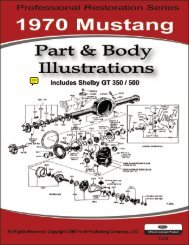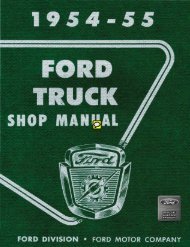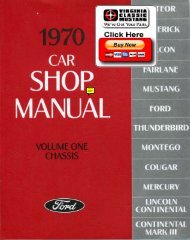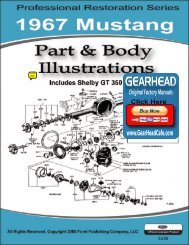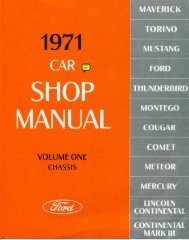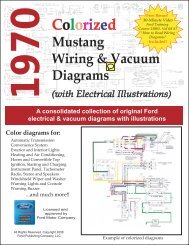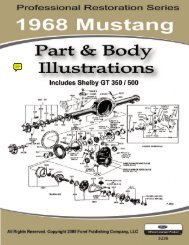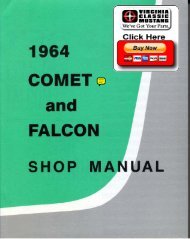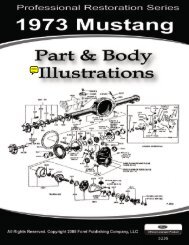DEMO - 1965 Ford Truck Shop Manual - ForelPublishing.com
DEMO - 1965 Ford Truck Shop Manual - ForelPublishing.com
DEMO - 1965 Ford Truck Shop Manual - ForelPublishing.com
Create successful ePaper yourself
Turn your PDF publications into a flip-book with our unique Google optimized e-Paper software.
2-58 GROUP 2 - BRAKES<br />
VALVE<br />
PISTON<br />
ROD SEAL<br />
H1059-A<br />
FIG. 45-Fast Application Valve<br />
and Piston Rod Seals<br />
flat side down. Remove the O-ring<br />
seal, snap ring and retainer washer,<br />
flange washer, push rod seal, and<br />
stop washer from the end plate (Fig<br />
46).<br />
(FRONT) END PLATE<br />
FLANGE<br />
WASHER<br />
BUSHING<br />
FIG. 46-Hydraulic Cylinder<br />
Push Rod Seals<br />
LEATHER<br />
SEAL<br />
HI 060-A<br />
23. Drive the push rod leather<br />
seal out of the end plate.<br />
24. Remove the retainer and stop<br />
washer from the valve fitting and remove<br />
the fitting. Push the hydraulic<br />
piston out of the valve fitting, and<br />
remove the gasket from the valve<br />
fitting (Fig. 47).<br />
25. Remove the cups from the hydraulic<br />
piston.<br />
ASSEMBLY<br />
1. Assemble the rear vacuum piston<br />
by installing the nut on the rear<br />
vacuum piston end of the piston rod<br />
with the flat side of the nut upward<br />
(Fig. 42).<br />
2. Position the larger diameter piston<br />
plate on the piston rod with the<br />
chamfered side of the hole at the<br />
top. Guide the rubber seal ring over<br />
the threads of the piston rod.<br />
3. Place an assembly ring on a<br />
flat surface and install the leather<br />
STOP<br />
WASHER<br />
RETAINER<br />
H1061-A<br />
FIG. 47-Hydraulic Control Valve<br />
Piston and Fitting<br />
packing, with the lip side upward.<br />
Then position the smaller diameter<br />
piston plate, with chamfered side of<br />
the hole downward, in the ring.<br />
4. Cut a new piece of wick to the<br />
required length, then place it against<br />
the inner face of the leather packing<br />
lip. Assemble the wick retainer, with<br />
the gripper points upward, against<br />
the wick, and hook the notched end<br />
of the retainer under the clip near<br />
the opposite end of the ring.<br />
5. Position the cut-out of the retainer<br />
plate over the loop of the<br />
wick retainer.<br />
6. Hold the piston parts in the assembly<br />
ring, assemble them on the<br />
end of the piston rod, then install<br />
the nut on top of the piston assembly.<br />
Tighten the nut until it is flush<br />
with the end of the piston rod. Stake<br />
the nut securely at two places.<br />
Clamp the staked nut firmly in a<br />
vise, and tighten the nut on the opposite<br />
side of the piston plate solidly<br />
against the piston plate.<br />
7. Press the fast application valve<br />
shaft and rod seals (Fig. 45), into the<br />
center plate. The piston valve shaft<br />
seal must be flush with the bottom<br />
of the hole. The piston rod seal<br />
should rest against the shoulder of<br />
the center plate.<br />
8. Position the center plate as<br />
shown in Fig. 44, then place the return<br />
spring on top of the seal with<br />
the small end at the top. Install the<br />
bullet-nosed tool on the threaded<br />
end of the valve shaft, and insert the<br />
valve shaft through the seal. Position<br />
the gasket on the center plate.<br />
9. Place the valve seat plate, with<br />
the seat side downward, on the gasket,<br />
and install the screws and lockwashers.<br />
10. Turn the center plate over.<br />
Place the lower diaphragm plate,<br />
with the rounded edge up, on the<br />
valve shaft, then place the diaphragm<br />
gasket on top of the plate<br />
(Fig. 43). Position the diaphragm on<br />
top of the gasket so the screw holes<br />
and the by-pass hole index with the<br />
identical holes in the center plate.<br />
Install the other diaphragm plate<br />
with the rounded edge facing the<br />
diaphragm.<br />
11. Install the nut on the valve<br />
shaft. Use a screwdriver to prevent<br />
the shaft from turning, and tighten<br />
the nut. Stake the nut securely at 2<br />
opposite points.<br />
12. Position the gasket and valve<br />
cover on the center plate, then install<br />
the screws and lock washers.<br />
13. Place the return spring over<br />
the piston rod with the small end of<br />
the spring at the bottom (Fig. 41).<br />
14. Carefully guide the piston rod<br />
through the seal in the center plate,<br />
with the piston stop flanges of the<br />
center plate facing upward. Press the<br />
center plate down against the spring,<br />
and insert a rod in the piston rod.<br />
15. Assemble the large end of the<br />
push rod in the end of the piston<br />
rod, and install the pin.<br />
16. Thread the piston rod nut on<br />
the piston rod, with the flat side of<br />
the nut upward, to the limit of the<br />
threads.<br />
17. If the front piston was disassembled<br />
to replace the leather piston<br />
packing, the cotton wicking, or<br />
other parts, assemble the piston parts<br />
in the assembly ring in the same<br />
order as the rear piston (Fig. 42).<br />
Hold the parts in the ring and turn<br />
the assembly ring over. Remove the<br />
larger diameter piston plate and seal.<br />
With the assembly ring still in place,<br />
guide the remaining piston parts<br />
over the end of the push rod and<br />
against the piston rod nut (Fig. 48).<br />
Carefully install the seal over the<br />
threads of the piston rod. Place the<br />
larger diameter piston plate on the<br />
piston rod, with the chamfered side<br />
of the hole toward the seal.<br />
18. Install the piston rod nut,<br />
with the flat side downward, on the<br />
end of the piston rod. Tighten the




